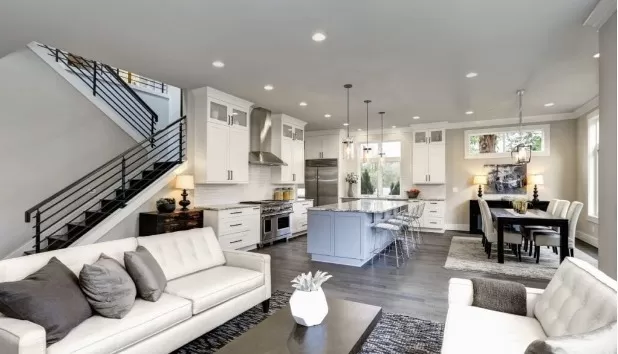Open floor plans have been a popular choice in modern home design for decades, but is it the right option for you? Explore the reasons why some buyers are opting for cozier, energy-efficient houses instead. Consider the drawbacks and potential limitations of open concept living before making a decision.
Factors Affecting Construction Costs in Open Floor Plans

Open floor plans have gained popularity for their spaciousness and flexibility, offering a seamless flow between different areas of a home.
However, it’s important to consider that building an open floor plan can have an impact on construction costs. One key factor that contributes to increased expenses is the absence of interior walls for structural support.
Here are some reasons why open floor plans can be more expensive to build:.
Structural Considerations:.
Increased load-bearing requirements: In the absence of interior walls, the load-bearing capacity of the structure needs to be distributed differently.
This often requires the use of heavier supporting beams or the incorporation of steel beams, which are more expensive than traditional wooden beams. Structural engineering and calculations: Designing an open floor plan requires specialized engineering to ensure the structural integrity of the building.
This involves additional calculations and planning to determine the appropriate beam sizes, column placements, and reinforcement, all of which contribute to the overall construction cost. Materials and Construction Methods:.
Heavier beams and materials: To compensate for the absence of interior walls, the supporting beams in open floor plans need to be stronger and sturdier.
This can result in the use of larger, more costly beams or steel members, which are generally more expensive than traditional wooden framing. Additional labor and expertise: Constructing an open floor plan may require specialized skills and knowledge to properly install the structural components.
Skilled laborers and contractors familiar with open floor plan construction may charge higher rates, further increasing the overall cost. Building Code and Permitting:.
Compliance with building codes: Open floor plans need to meet specific building code requirements, including regulations related to structural stability and fire safety.
Compliance with these codes may involve additional inspections, permits, and compliance costs, all of which can contribute to the overall construction expenses. It’s important to note that while open floor plans may come with additional construction costs, they offer numerous benefits in terms of functionality, aesthetics, and the ability to create a spacious living environment.
The overall cost will depend on various factors, including the size of the space, the complexity of the design, the choice of materials, and the location.
When considering an open floor plan, it’s advisable to consult with experienced architects, structural engineers, and contractors who can provide accurate cost estimates and guide you through the construction process.
By understanding the potential cost implications and planning accordingly, you can achieve your desired open floor plan while managing the construction expenses effectively.
Balancing Privacy in Open Floor Plans
Open floor plans are known for their spaciousness and seamless flow, but one of the trade-offs is a potential lack of privacy.
With the absence of interior walls and separate rooms, maintaining privacy becomes a challenge. Here are some considerations to address the issue of privacy in open floor plans:.
Strategic Furniture Placement:.
Utilize furniture as partitions: Arrange furniture strategically to create visual barriers and define separate areas within the open space.
For example, placing a sofa or bookshelf strategically can help delineate the living room from the dining area. Use room dividers: Incorporate decorative room dividers or screens to create temporary partitions and provide visual separation when desired.
Designated Zones:.
Create designated areas: Design the layout in a way that allows for designated zones within the open space.
This can include creating cozy reading corners, study nooks, or workspaces that provide a sense of personal space within the larger area. Consider half-walls or partial partitions: Introducing partial walls or half-walls can offer a sense of separation while still maintaining the openness of the overall space.
Window Treatments and Curtains:.
Install window treatments: Use curtains, blinds, or shades to control the visibility and add privacy when needed.
These can be used to cover windows facing outside or to separate different areas within the open floor plan. Privacy films: Apply privacy films to windows or glass panels to obscure the view while still allowing natural light to enter the space.
Incorporate Design Elements:.
Use visual barriers: Introduce design elements such as decorative screens, built-in shelving, or architectural features like columns or archways to create visual barriers and add a sense of privacy.
Play with levels: Incorporate steps, platforms, or changes in floor levels to subtly differentiate spaces and provide a feeling of separation. Flexible Solutions:.
Sliding doors or pocket doors: Install sliding or pocket doors that can be closed when privacy is desired, allowing for a temporary separation of spaces.
Window treatments for glass walls: If your open floor plan includes glass walls or partitions, consider using frosted or opaque films that maintain natural light while providing privacy. While open floor plans may limit traditional privacy, implementing these strategies can help strike a balance between openness and personal space.
It’s important to assess your specific needs and preferences when designing and organizing the space, taking into account factors such as the number of occupants, lifestyle, and desired level of privacy.
By carefully considering furniture placement, incorporating design elements, and utilizing window treatments, you can create pockets of privacy within an open floor plan, allowing for a harmonious blend of shared space and personal retreats.
Striking a Balance: Cooking Privacy in Open Floor Plans

Open floor plans offer a spacious and connected living experience, but they can present challenges when it comes to cooking in full view of guests.
Many cooks prefer a certain level of privacy in the kitchen, whether it’s for personal comfort, culinary focus, or the freedom to make adjustments without scrutiny. Here are some tips to balance cooking privacy in open floor plans:.
Kitchen Layout and Design:.
Separate cooking zone: When designing your open floor plan, consider positioning the kitchen area slightly away from the main gathering space.
This can be achieved through the placement of an island, a partial wall, or a different floor level to create a visual and physical separation. Utilize kitchen islands: Islands can serve as a practical and functional barrier between the cooking area and the rest of the space.
They provide additional workspace and can act as a buffer zone, allowing you to focus on cooking while still engaging with guests. Smart Storage Solutions:.
Concealment through cabinetry: Well-designed cabinetry can help hide the messier aspects of cooking and provide a sense of privacy.
Incorporate ample storage to keep countertops clutter-free and ensure easy access to cooking essentials. Consider walk-in pantries: If space permits, a walk-in pantry adjacent to the kitchen can offer a designated area for food prep, storage, and minor kitchen tasks.
This allows you to keep ingredients and utensils organized and out of direct sight from guests. Kitchen Screen or Divider:.
Utilize decorative screens: Install decorative screens or room dividers in the kitchen to create a visual barrier between the cooking area and the rest of the open floor plan.
This allows you to maintain a level of privacy while still maintaining the overall openness of the space. Sliding doors or curtains: Install sliding doors or curtains that can be drawn to separate the kitchen from the main living area when desired.
This provides the flexibility to hide the cooking area and control visibility. Prep and Cleanup Zones:.
Designate prep areas: Create a designated prep area in the kitchen where you can comfortably handle food preparation tasks away from the direct view of guests.
This can be a separate counter or an extended portion of the kitchen island. Concealment during cleanup: Design the kitchen in a way that allows for a separate cleanup zone, such as a sink and dishwasher area, where you can tidy up without guests observing the post-cooking mess.
Cooking Accessories and Tools:.
Utilize backsplash or wall coverings: Opt for a backsplash or wall coverings that are easy to clean and resistant to stains.
This can help maintain a neat and presentable appearance even during cooking activities. Portable cooking accessories: Consider using portable cooking accessories like induction cooktops or tabletop grills.
This allows you to bring the cooking process to a more private area, such as the kitchen island, while still being able to interact with guests. Remember, the goal is to strike a balance between an open and connected living space and the privacy needed for cooking.
By carefully planning the layout, incorporating smart storage solutions, and utilizing decorative screens or dividers, you can create a kitchen area that allows you to enjoy your culinary pursuits while still engaging with your guests in a way that feels comfortable and enjoyable.
Managing Food Odors in Open Floor Plans

Open floor plans offer a seamless flow between the kitchen and living spaces, but they can also allow food odors to spread throughout the entire area.
If you want to prevent lingering smells and maintain a fresh environment, here are some tips for managing food odors in open floor plans:.
Ventilation and Air Circulation:.
Range hood or exhaust fan: Ensure your kitchen is equipped with a range hood or exhaust fan that vents outside.
This helps to remove cooking odors and steam directly from the source. Open windows: When weather permits, open windows in the kitchen and living areas to allow fresh air to circulate and help dissipate any lingering smells.
Ceiling Fans and portable fans: Use ceiling fans or portable fans strategically to improve air circulation and help disperse odors. Cooking Techniques and Ingredients:.
Use lids and covers: When cooking strong-smelling foods, such as fish or spices, use lids and covers to contain the aromas and prevent them from spreading throughout the open floor plan.
Simmer with natural deodorizers: While cooking, add natural deodorizers like lemon slices, herbs (such as rosemary or thyme), or vinegar to simmering water. These ingredients can help neutralize odors and leave a fresh scent in the air.
Cleaning and Maintenance:.
Regular cleaning routine: Develop a regular cleaning routine for your kitchen to minimize odors.
Wipe down surfaces, clean appliances, and wash dishes promptly to prevent food residue from lingering and causing unpleasant smells. Deep cleaning: Perform regular deep cleaning of your kitchen, including appliances, cabinets, and floors, to remove any trapped odors or grease buildup that may contribute to persistent smells.
Upholstery maintenance: Vacuum upholstered furniture regularly and consider using fabric sprays or air fresheners specifically designed to eliminate odors. Odor Absorbing Techniques:.
Natural odor absorbers: Place bowls of baking soda, activated charcoal, or coffee grounds in the kitchen or nearby areas to absorb and neutralize odors over time.
Fresh herbs and citrus: Display fresh herbs like mint, basil, or lavender in vases or bowls, or use citrus fruits like lemons or oranges as natural air fresheners. These can help mask any lingering food odors with pleasant scents.
Separate Storage:.
Airtight containers: Store leftover food in airtight containers to prevent odors from permeating the refrigerator or pantry and spreading to other areas.
Separate storage for strong-smelling items: If possible, designate a specific storage area for strong-smelling ingredients or foods to minimize their impact on the rest of the living space. Scented Candles or Air Purifiers:.
Scented candles or diffusers: Use scented candles or oil diffusers with fragrances that help mask or neutralize food odors.
Opt for natural scents like citrus, herbs, or floral notes. Air purifiers: Consider using an air purifier with a built-in odor elimination feature to continuously filter the air and remove unwanted odors.
By implementing these strategies, you can effectively manage and minimize food odors in open floor plans, creating a more pleasant and fresh living environment for both you and your guests.
*The information is for reference only.